Another strong upwards day continues price towards the Elliott wave target.
Summary: The next target at 3,179 is where minor wave 4 may begin (expect it to be very shallow). Thereafter, the next target is at 3,302 and then 3,336.
Three large pullbacks or consolidations during the next few months are expected: for minor wave 4, then intermediate (4), and then primary 4. Prior to each of these large corrections beginning, some weakness may begin to be evident.
The biggest picture, Grand Super Cycle analysis, is here.
Monthly charts were last published here, with video here. There are two further alternate monthly charts here, with video here.
ELLIOTT WAVE COUNTS
The two weekly Elliott wave counts below will be labelled First and Second. They may be about of even probability. When the fifth wave currently unfolding on weekly charts may be complete, then these two wave counts will diverge on the severity of the expected following bear market. To see an illustration of this future divergence monthly charts should be viewed.
FIRST WAVE COUNT
WEEKLY CHART
The basic Elliott wave structure consists of a five wave structure up followed by a three wave structure down (for a bull market). This wave count sees the bull market beginning in March 2009 as an incomplete five wave impulse and now within the last fifth wave, which is labelled cycle wave V. This impulse is best viewed on monthly charts. The weekly chart focusses on the end of it.
Elliott wave is fractal. This fifth wave labelled cycle wave V may end a larger fifth wave labelled Super Cycle wave (V), which may end a larger first wave labelled Grand Super Cycle wave I.
The teal Elliott channel is drawn using Elliott’s first technique about the impulse of Super Cycle wave (V). Draw the first trend line from the end of cycle wave I (off to the left of the chart, the weekly candlestick beginning 30th November 2014) to the end of cycle wave III, then place a parallel copy on the end of cycle wave II. This channel perfectly shows where cycle wave IV ended at support. The strongest portion of cycle wave III, the end of primary wave 3, overshoots the upper edge of the channel. This is a typical look for a third wave and suggests the channel is drawn correctly and the way the impulse is counted is correct.
Within Super Cycle wave (V), cycle wave III is shorter than cycle wave I. A core Elliott wave rule states that a third wave may never be the shortest. For this rule to be met in this instance, cycle wave V may not be longer in length than cycle wave III. This limit is at 3,477.39.
Cycle wave V may subdivide either as an impulse or an ending diagonal. Impulses are much more common. An alternate wave count, which looked at the possibility of a diagonal unfolding, has been invalidated with a new all time high.
The daily chart below will focus on movement from the end of intermediate wave (1) within primary wave 3.
In historic analysis, two further monthly charts have been published that do not have a limit to upwards movement and are more bullish than this wave count. Members are encouraged to consider those possibilities (links below summary) alongside the wave counts presented on a daily and weekly basis.
Within cycle wave V, primary waves 1 and 2 may be complete. Within primary wave 3, intermediate waves (1) and (2) may be complete. Within the middle of intermediate wave (3), no second wave correction may move beyond its start below 2,855.96.
DAILY CHART
All of primary wave 3, intermediate wave (3) and minor wave 3 may only subdivide as impulses.
Minor wave 3 may be underway and may be nearing its end. Minor wave 3 now shows an increase in momentum beyond minor wave 1; MACD supports this wave count.
Minor wave 4 may not move into minor wave 1 price territory below 3,021.99.
Intermediate wave (3) must move far enough above the end of intermediate wave (1) to then allow intermediate wave (4) to unfold and remain above intermediate wave (1) price territory. While intermediate wave (3) has now moved beyond the end of intermediate wave (1), meeting a core Elliott wave rule, it still needs to continue higher to give room for intermediate wave (4).
The target for intermediate wave (3) fits with a target calculated for minor wave 3.
Minor wave 2 was a sharp deep pullback, so when it arrives minor wave 4 may be expected to be a very shallow sideways consolidation to exhibit alternation. Minor wave 2 lasted 2 weeks, so minor wave 4 may be about the same duration to have good proportion.
HOURLY CHART
There are multiple ways now to label upwards movement from the end of minor wave 2.
At the end of this week, after considering various possibilities, the hourly chart for minor wave 3 is relabelled. This labelling has the right look.
There is alternation between a quick deep zigzag of minute wave ii and a more time consuming sideways triangle of minute wave iv.
There is no Fibonacci ratio between minute waves iii and i.
Fibonacci ratios within minute wave iii are: minuette wave (iii) is 5.81 points longer than equality with minuette wave (i), and minuette wave (v) is just 0.49 points short of 0.146 the length of minuette wave (i).
Draw an Elliott channel about minor wave 3 using Elliott’s first technique: draw the first trend line from the end of minute wave i to minute wave iii, then place a parallel copy on the end of minute wave ii. Minute wave iv remains within the channel. The channel may show where minute wave v finds support and resistance along the way up.
The invalidation point is left at the last smalll swing low to allow for the possibility that minute wave iv was over there. Within minute wave v, no second wave correction may move beyond its start below 3,078.80.
SECOND WAVE COUNT
WEEKLY CHART
This weekly chart is almost identical to the first weekly chart, with the sole exception being the degree of labelling.
This weekly chart moves the degree of labelling for the impulse beginning in March 2009 all down one degree. This difference is best viewed on monthly charts.
The impulse is still viewed as nearing an end; a fifth wave is still seen as needing to complete higher. This wave count labels it primary wave 5.
Primary wave 5 may be subdividing as either an impulse, in the same way that cycle wave V is seen for the first weekly chart.
TECHNICAL ANALYSIS
WEEKLY CHART
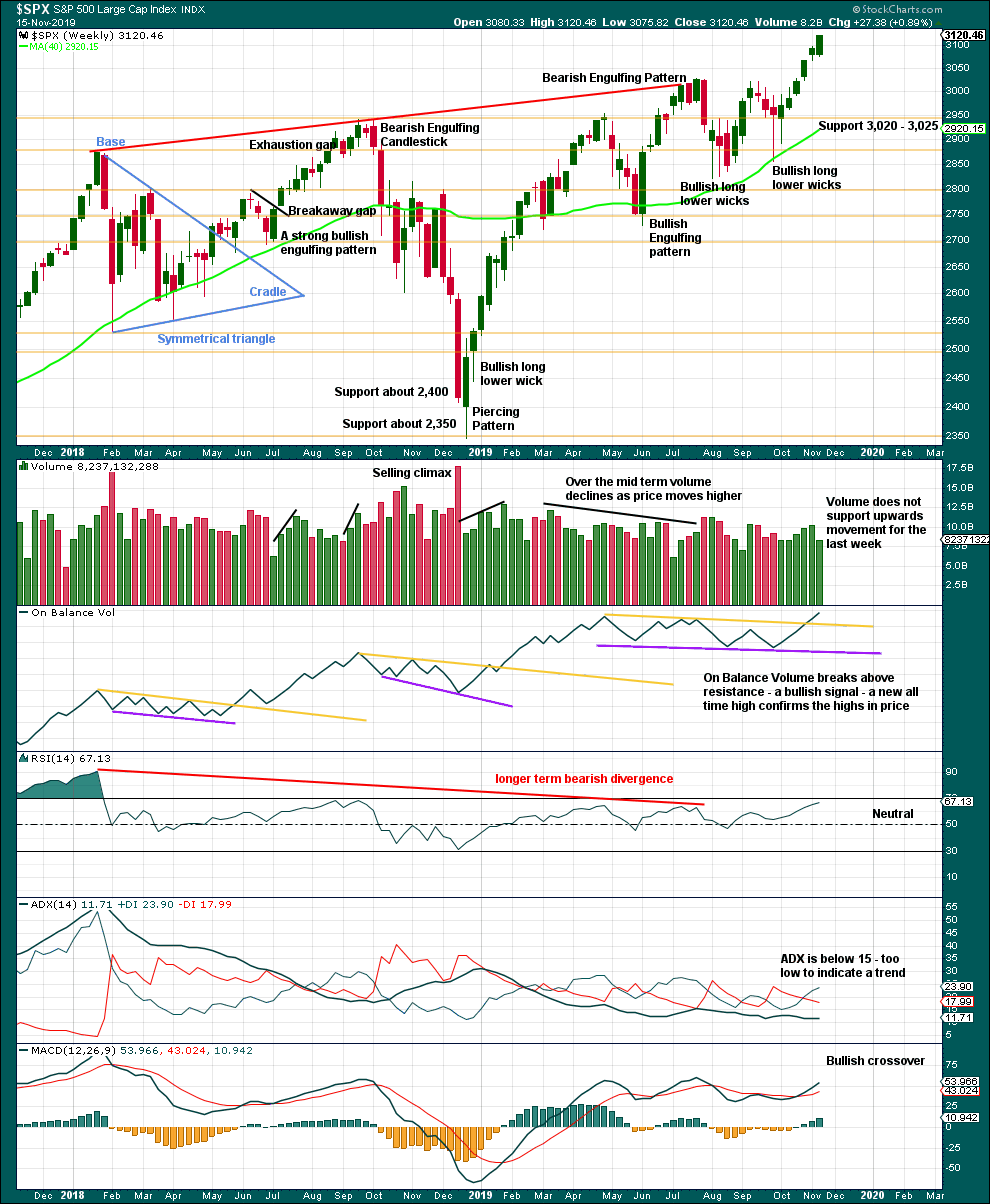
Click chart to enlarge. Chart courtesy of StockCharts.com.
It is very clear that the S&P is in an upwards trend and the bull market is continuing. Price does not move in straight lines; there will be pullbacks and consolidations along the way.
Now that resistance has been overcome, energy has been released to the upside and there are now six green weekly candlesticks in a row. Corrections are normal and to be expected; they may be more short term in nature at this stage.
This week price has closed near highs for the week; more upwards movement may be expected next week.
Some decline overall in volume this week is not of a great concern in current market conditions. This may be an early development of some weakness as minor wave 3 nears its end.
DAILY CHART
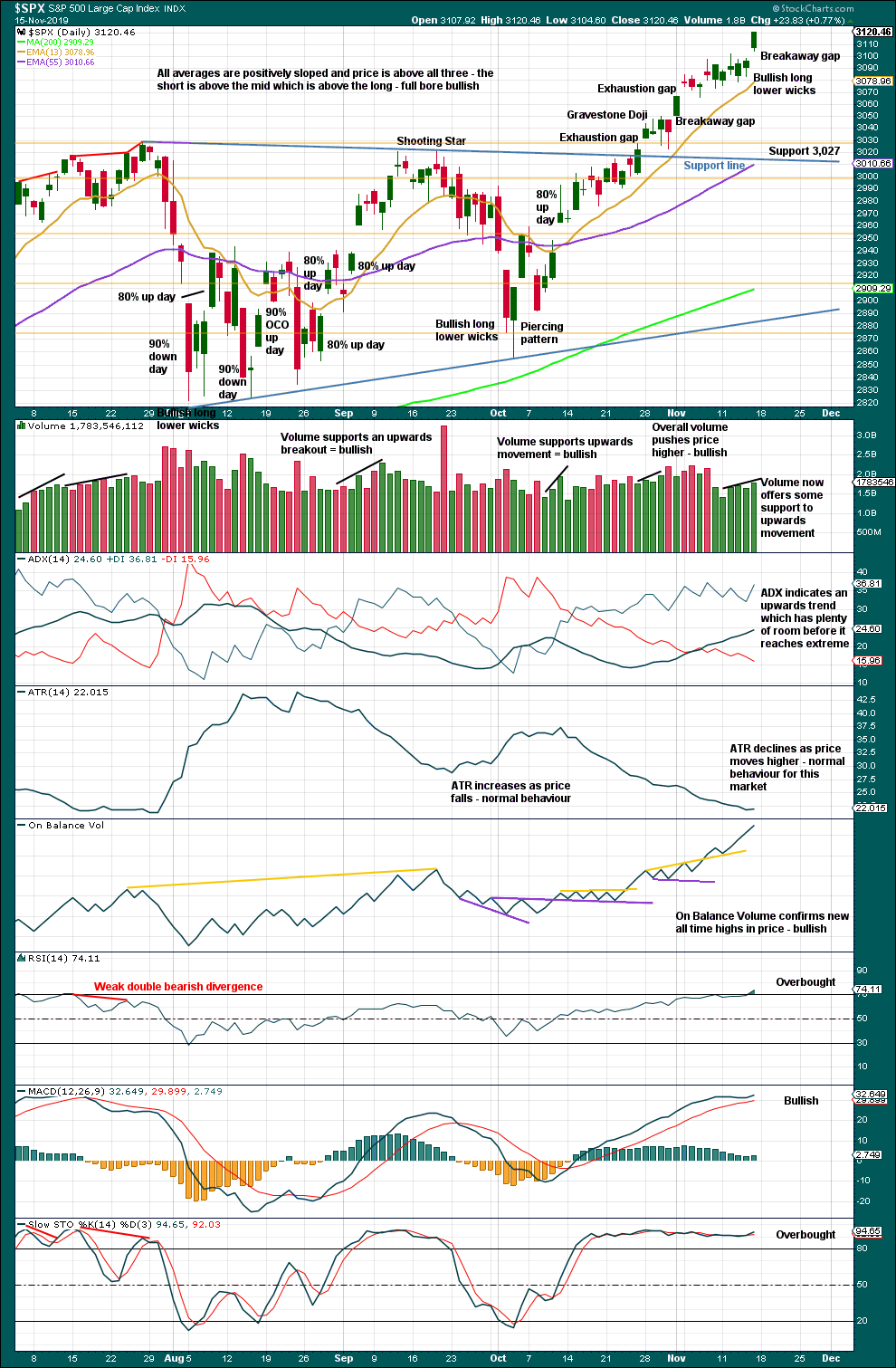
Click chart to enlarge. Chart courtesy of StockCharts.com.
There is an upwards trend in place. There will be corrections along the way.
The breakaway gap may offer support at 3,098.20.
When this market is in a bullish trend, RSI can reach deeply overbought and remain there for some weeks.
BREADTH – AD LINE
WEEKLY CHART
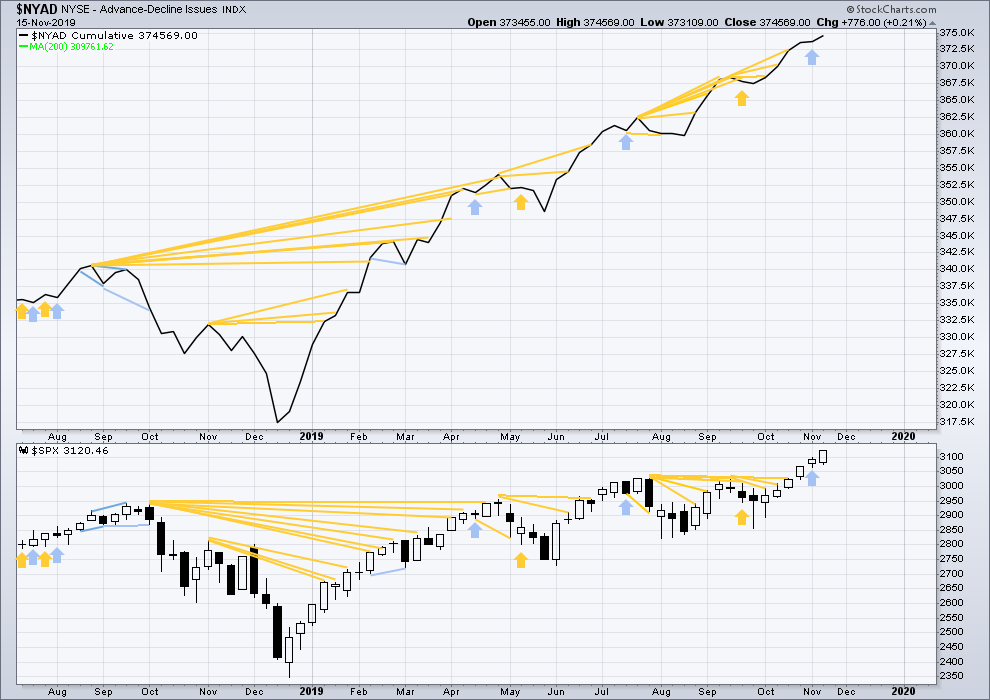
Click chart to enlarge. Chart courtesy of StockCharts.com. So that colour blind members are included, bearish signals
will be noted with blue and bullish signals with yellow.
Bear markets from the Great Depression and onwards have been preceded by an average minimum of 4 months divergence between price and the AD line with only two exceptions in 1946 and 1976. With the AD line making new all time highs this week, the end of this bull market and the start of a new bear market is very likely a minimum of 4 months away, which is mid March 2020.
In all bear markets in the last 90 years there is some positive correlation (0.6022) between the length of bearish divergence and the depth of the following bear market. No to little divergence is correlated with more shallow bear markets. Longer divergence is correlated with deeper bear markets.
If a bear market does develop here, it comes after no bearish divergence. It would therefore more likely be shallow.
All of small, mid and large caps have made new swing highs above the prior swing high on the 13th of September, but only large caps have made new all time highs. This upwards movement appears to be mostly driven by large caps, which is a feature of aged bull markets. This bull market at over 10 years duration certainly fits the definition of aged.
Mid and small caps have not yet made new all time highs.
This week both price and the AD line have made new all time highs. Upwards movement has support from rising market breadth. This is bullish.
DAILY CHART
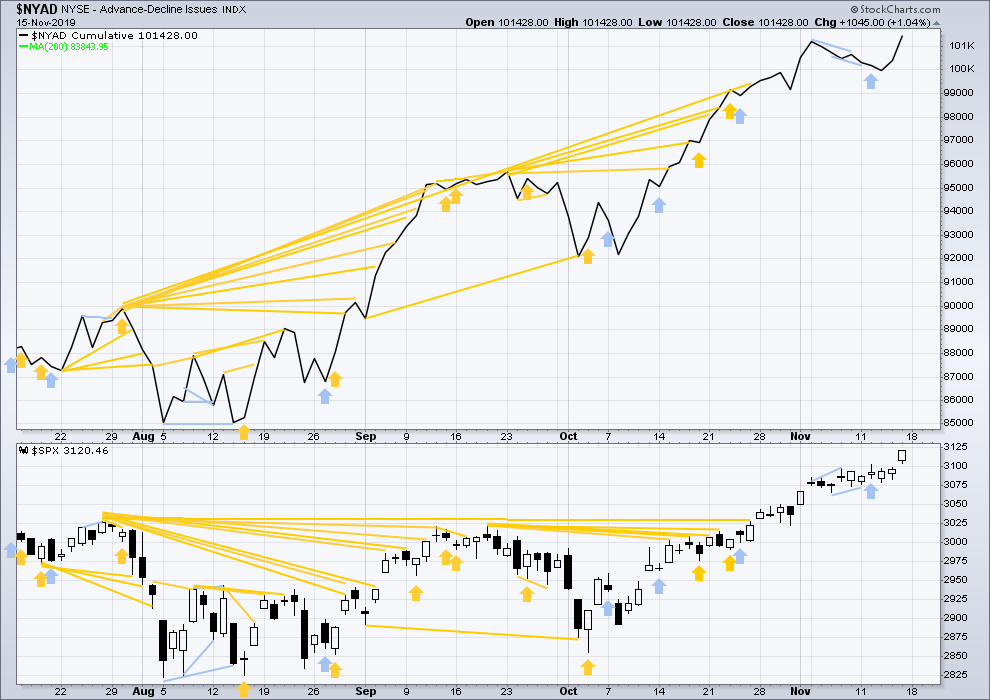
Click chart to enlarge. Chart courtesy of StockCharts.com. So that colour blind members are included, bearish signals
will be noted with blue and bullish signals with yellow.
Breadth should be read as a leading indicator.
Both price and the AD line have made new all time highs. Upwards movement has support from rising market breadth. This is bullish.
VOLATILITY – INVERTED VIX CHART
WEEKLY CHART

Click chart to enlarge. Chart courtesy of StockCharts.com. So that colour blind members are included, bearish signals
will be noted with blue and bullish signals with yellow.
The all time high for inverted VIX was on 30th October 2017. There is now over two years of bearish divergence between price and inverted VIX.
The rise in price is not coming with a normal corresponding decline in VIX; VIX remains elevated. This long-term divergence is bearish and may yet develop further as the bull market matures.
This divergence may be an early warning, a part of the process of a top developing that may take years. It may is clearly not useful in timing a trend change from bull to a fully fledged bear market.
This week price moves higher, but inverted VIX is essentially flat. This divergence is bearish for the short term, but it is not strong and shall be given no weight in this analysis.
DAILY CHART

Click chart to enlarge. Chart courtesy of StockCharts.com. So that colour blind members are included, bearish signals
will be noted with blue and bullish signals with yellow.
Both price and inverted VIX have made new short-term swing highs. There is no new short-term divergence.
DOW THEORY
Dow Theory confirmed a bear market in December 2018. This does not necessarily mean a bear market at Grand Super Cycle degree though; Dow Theory makes no comment on Elliott wave counts. On the 25th of August 2015 Dow Theory also confirmed a bear market. The Elliott wave count sees that as part of cycle wave II. After Dow Theory confirmation of a bear market in August 2015, price went on to make new all time highs and the bull market continued.
DJIA: 23,344.52 – a close on the 19th of December at 23,284.97 confirms a bear market.
DJT: 9,806.79 – price has closed below this point on the 13th of December.
S&P500: 2,532.69 – a close on the 19th of December at 2,506.96 provides support to a bear market conclusion.
Nasdaq: 6,630.67 – a close on the 19th of December at 6,618.86 provides support to a bear market conclusion.
With all the indices having moved higher following a Dow Theory bear market confirmation, Dow Theory would confirm a bull market if the following highs are made:
DJIA: 26,951.81 – a close above this point has been made on the 3rd of July 2019.
DJT: 11,623.58 – to date DJT has failed to confirm an ongoing bull market.
S&P500: 2,940.91 – a close above this point was made on the 29th of April 2019.
Nasdaq: 8,133.30 – a close above this point was made on the 26th of April 2019.
Published @ 09:12 p.m. EST.
—
Careful risk management protects your trading account(s).
Follow my two Golden Rules:
1. Always trade with stops.
2. Risk only 1-5% of equity on any one trade.
—
New updates to this analysis are in bold.

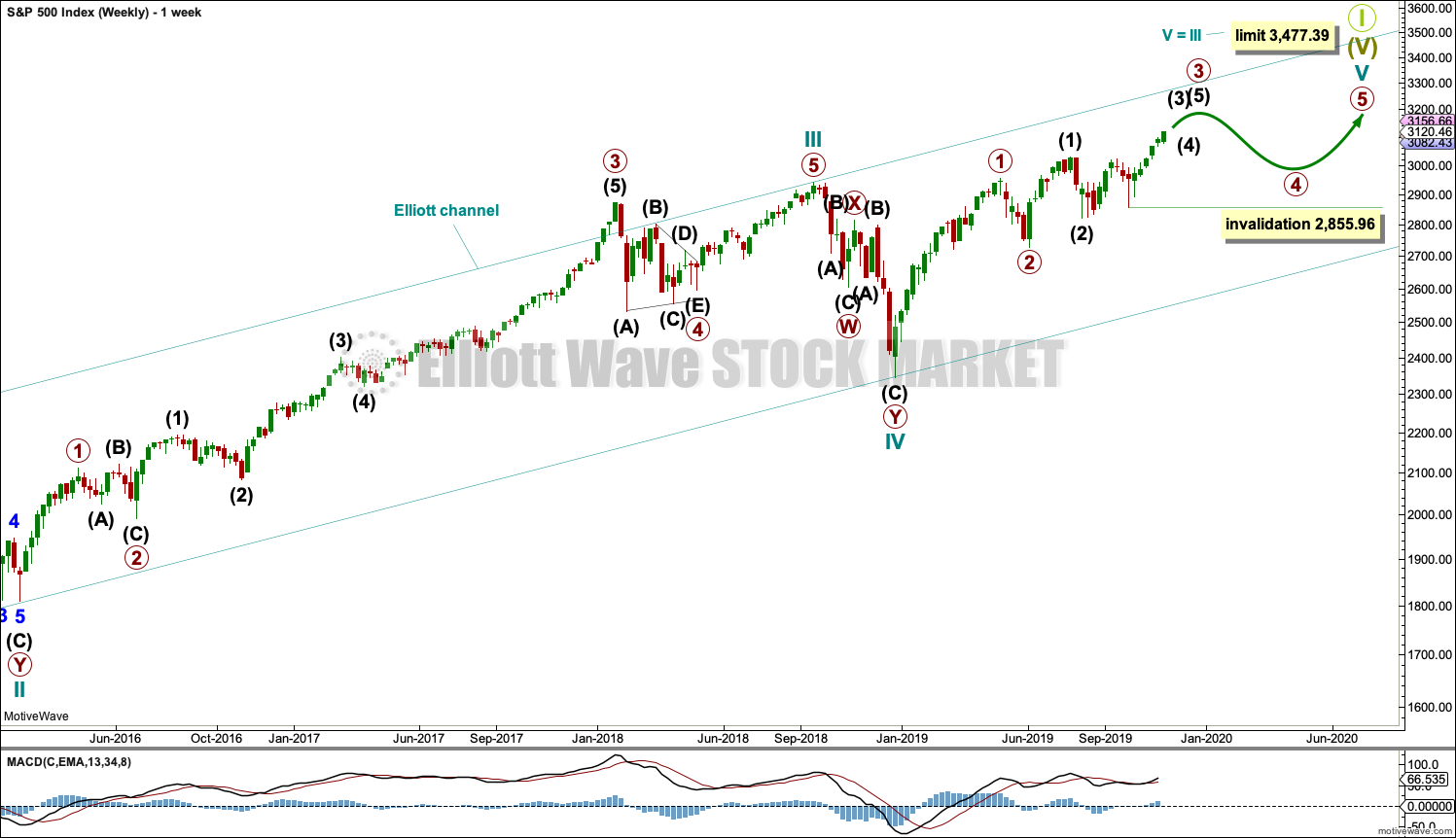
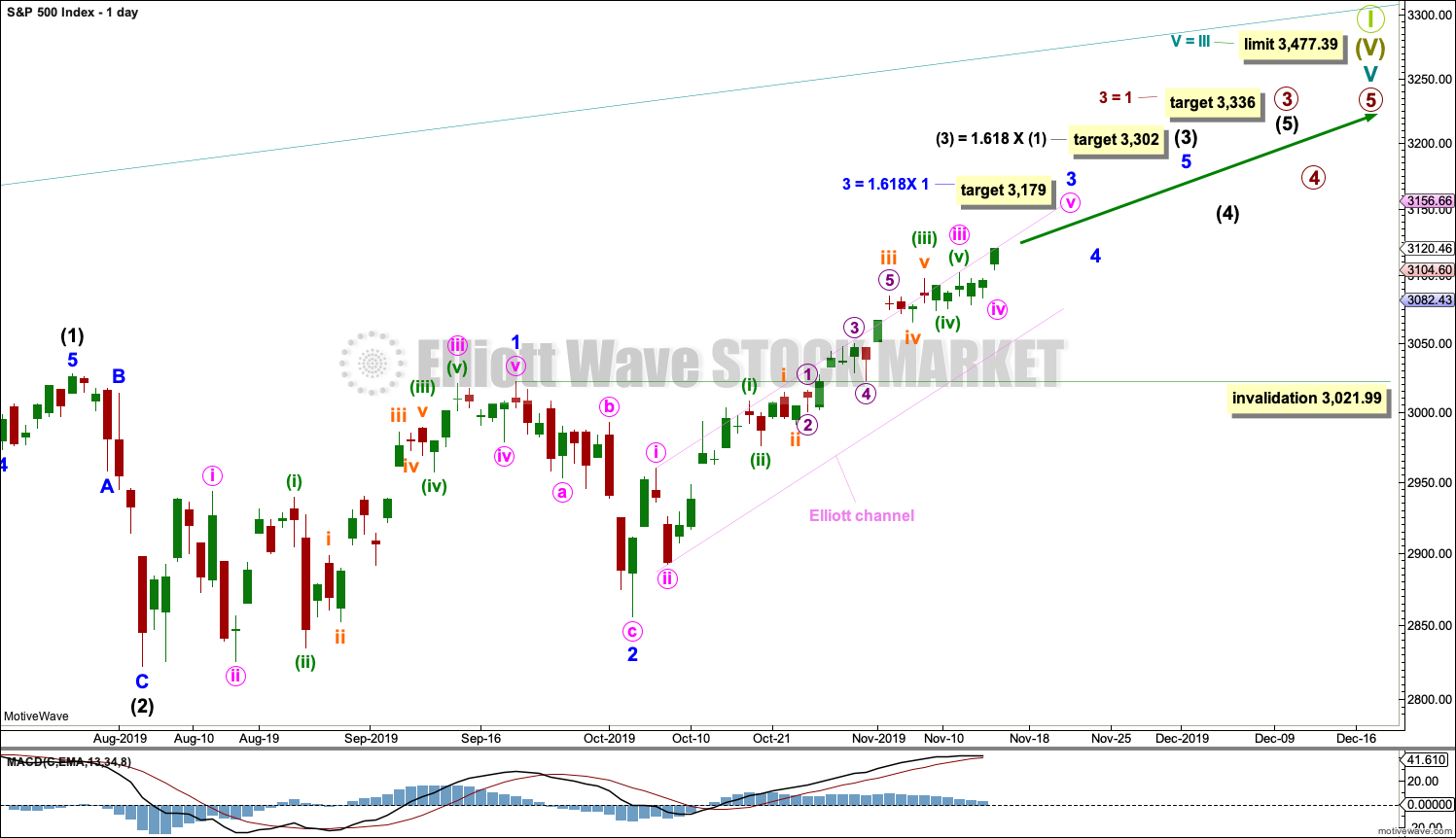
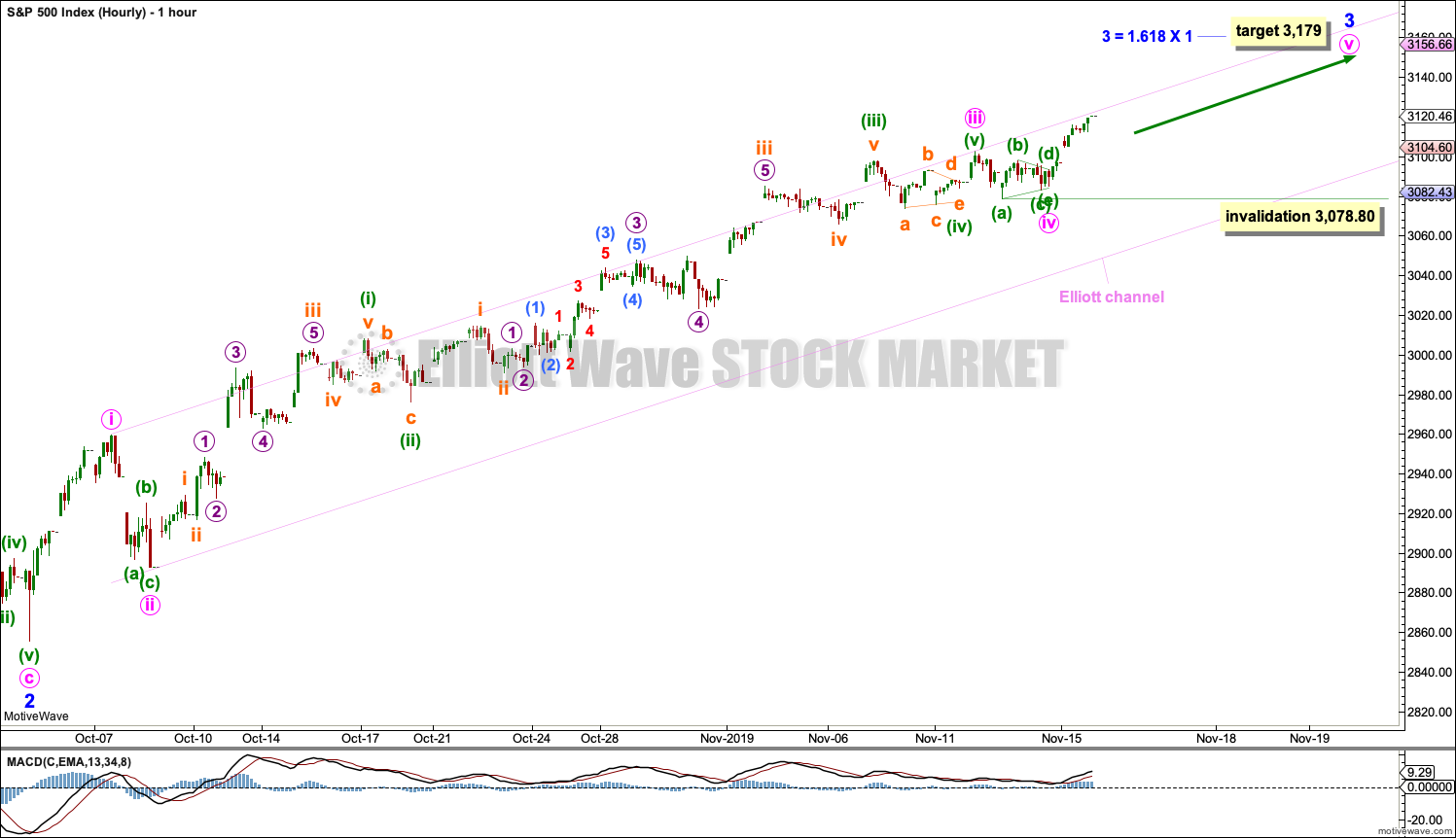
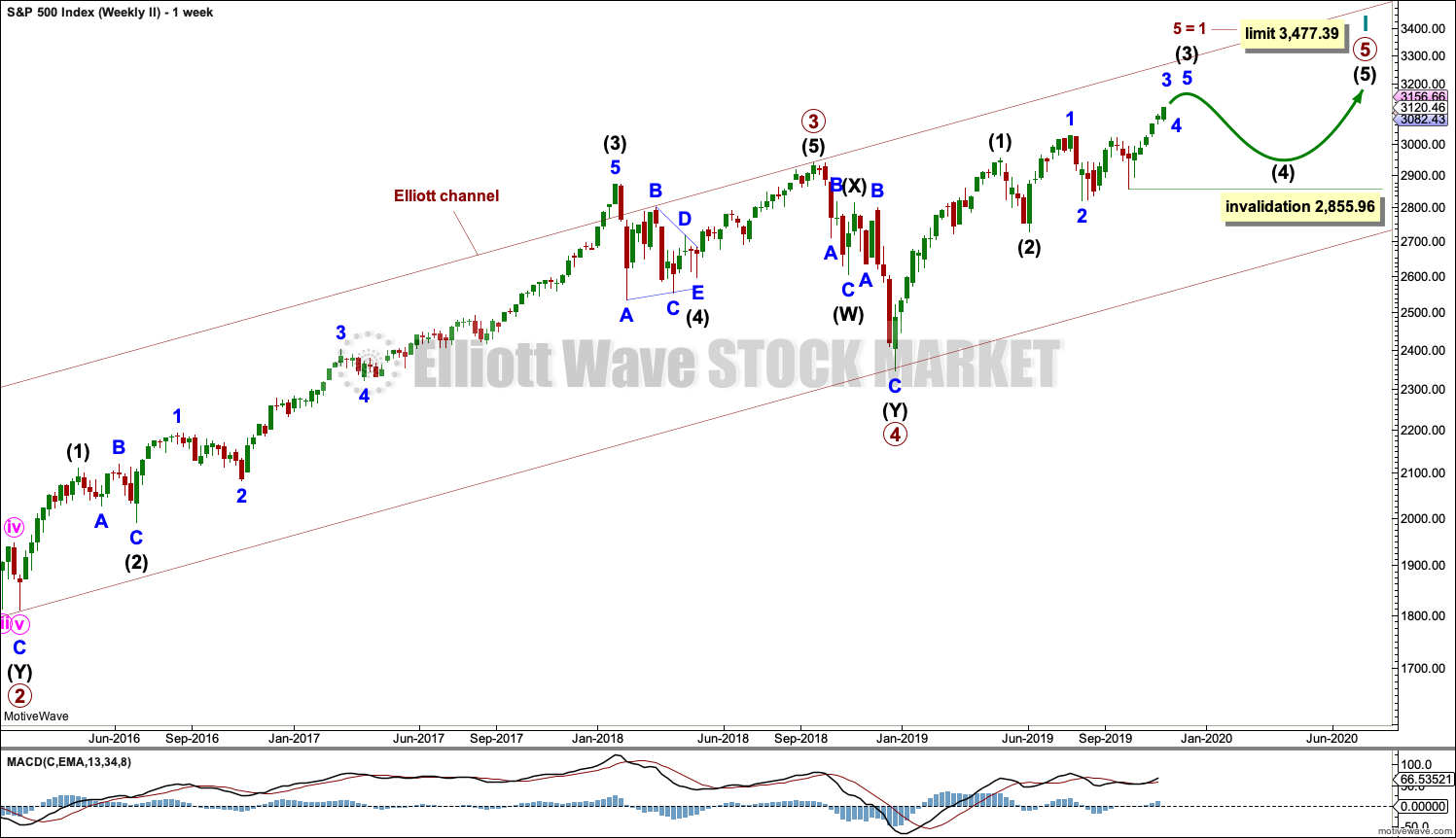
Hourly chart updated.
Onwards and upwards to the target.
Some possible resistance just over head; 161.2% extension of a prior down downswing, and a Fibonacci fitted target for potential completion of the entire bull run. Just to stay aware of.
Also RUT’s inability to make any kind of move matching the SPX and NDX move up and away over the last few days gives me some pause. RUT is looking like a minor 2 in progress…but still very shallow. And continued relative weakness today.
I am a member of the Board of Trustees for a non-profit philanthropic organization. I am meeting with our financial adviser from Morgan Stanley on Thursday evening. I am interested to hear what Morgan Stanley advisers are thinking about the next 1-3 years for the US & International economies as well as equities & bonds. I spoke with him this morning by phone and he is almost giddy. Exactly what you would expect when we are at all time highs! He will have good news to report to us and we will be able to give out more in gifts.
Right now I expect the surprisingly strong retail numbers for October to be reproduced for November and then the Christmas season. I am looking for a strong Santa Claus rally into year end.
I would expect bullish sentiment to increase to extreme levels at the end of intermediate (3) and also the end of primary 3.
Maybe not the end of minor 3 though. So not quite yet.
It’s not yet extreme.
I’m taking profits on my couple of spreads at or above 80% of max profit, and closing bull call spreads that are right around break even. Holding positions firmly in the money that need to mature for another 30 days…only. Generally lightening, getting ready for this minor 4. “Everything” looks quite extended to me. An example would be GS, where I had a bull call spread slightly in the red; gone now! Watching closely for topping structure in averages and particular issues (AAPL is one key one). “Follow the wave count Luke…”
I even put sold a bear call spread 150-152.5 in CAT…it’s turning in a long term resistance zone. Manufacturing has been hot and it’s turning here might be a canary.
I think the SPX has met the requirement for triangle exit, and I’m not comfortable remaining long here.
Obviously don’t want to be short, as there is no clear stop to use.
Given low level of volatility, I’m opening a long VIXY. I do not anticipate VIX to drop if the rally continue, and we should see VIX in the mid-teens if some drop materializes.
Here’s that “right next to each other” double triangle in SPX that just occurred. A thing of delicate beauty! 5 minute chart.
It is beautiful, isn’t it.
Hey, maybe I could prepare a nice looking 5 minute chart with all the subdivsions in all their different colours that could be printed off, as a real geeky kind art work 🙂
TBH, it’s the only kind of “art” I’m ever gonna be able to produce. Even my stick figures look just… wrong.
On the 15 minute the candles are not too squished together and you can see both triangles nicely
BTC-USD daily chart updated:
Minor wave 2 may be done here or very soon. The invalidation point remains the same at the start of minor wave 1. However, volume is pushing price lower at the daily chart basis, it may continue lower for another one to very few days. On the weekly chart volume is declining.
This chart is provided in comments only, rather than a full analysis of BTC-USD, simply because after preparing the Invysis intra-month report today I have run out of energy.
Thanks for this Lara.
I’m long with a very small position and may add when the minuette iv (up) is exceeded to the upside.
Thanks Lara. Thanks for all the effort and energy you put into your work.
Go bulls!
“Rollin’ rollin’ rolling’, keep those markets rollin’….!!!”
Sure is a lot easier to make money in these conditions than what we suffered through over the last 20 months!
Now…just gotta avoid getting destroyed by a sudden 6% sell off (not that I think one is coming but as the movie said, “Protect yourself at ALL TIMES!!”). Which for me means staying alert and with a crystal clear decision tree for exiting swiftly should the environment suddenly change. Never forget that a mere tweet can change sentiment instantly.